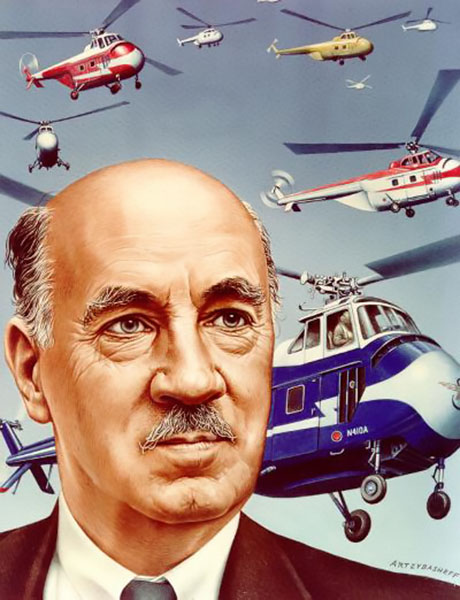Personal Recollections
The Most Unforgettable Character I’ve Met
by Eugene E. Wilson, from Reader's Digest, December 1956
On a gloomy day in 1938 I sat at my desk in East Hartford, Connecticut, and reluctantly awaited a visitor. As senior vice-president of United Aircraft, I had been delegated to put a valued friend out of business, perhaps even end his brilliant career. He was one of the world’s greatest aviation inventor, Igor Ivanovich Sikorsky.
As our meeting drew near, I recalled the meteoric rise of this Russian genius-how as a young man of 22 in his native Kiev he had broken the world’s flying record with a plane he had designed and built with the help of schoolmates from the polytechnic institute; of his swift triumph as a builder of giant aircraft, a hero to his compatriots. I thought of his escape after the Red revolution to this country, and his starvation days in the early 20’S, when he and other refugees pooled their poverty and built aircraft from junkshop parts on a Long Island farm near Roosevelt Field. Finally came his great planes which bore the Sikorsky “Winged S” symbol to the ends of the world.
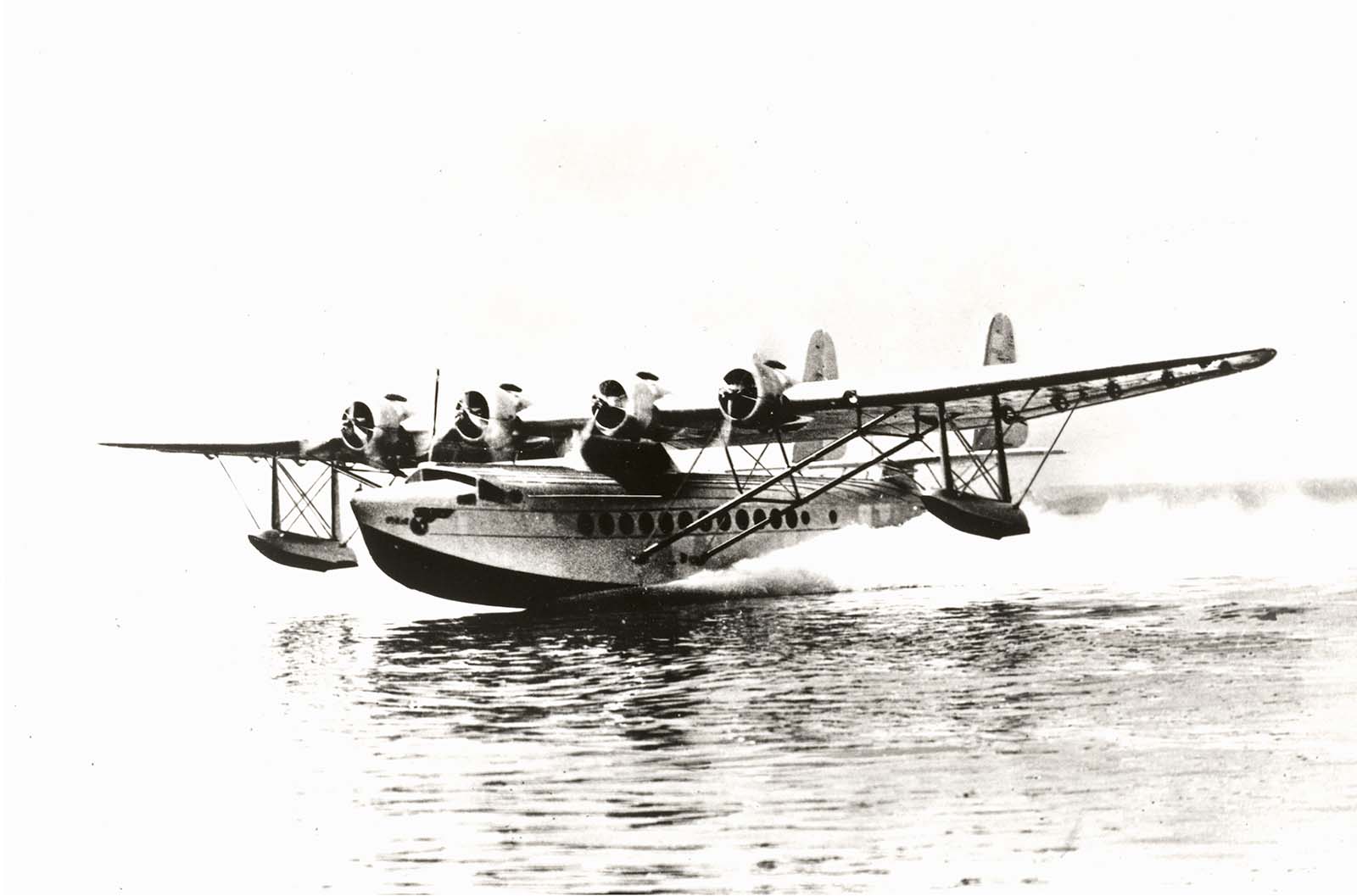
He stood in the doorway now, a slight professorial figure somewhat foreign to an aircraft-engine factory. His thin black mustache, drooping to the corners of his mouth, suggested a Tartar tribesman, but his soft dark eyes bespoke the mysticism of an Asiatic holy man. Advancing a few steps, he placed his heels together and bowed. From his decorous reserve one might have thought us strangers; actually we had worked together closely for years.
Just before the Depression, United Aircraft had purchased the Sikorsky firm at Stratford, Conn., and in 1930 I was made head of it. It was, I soon discovered, the strangest factory on earth. It bulged with charming, urbane, temperamental White Russian refugees – some of them admittedly talented – who had followed their great inventor to freedom. When the Grand Duchess Marie visited the plant, former aristocrats rose from benches and wheels stopped while the great lady held court. When Bridgeport’s Community Grand Opera Co., full of Sikorsky’s Russians, gave a performance, the triumph of an aria was at least as important as an airplane order, and the group’s moving spirit, a former Cossack major general, had to remain on the payroll, depression or not.
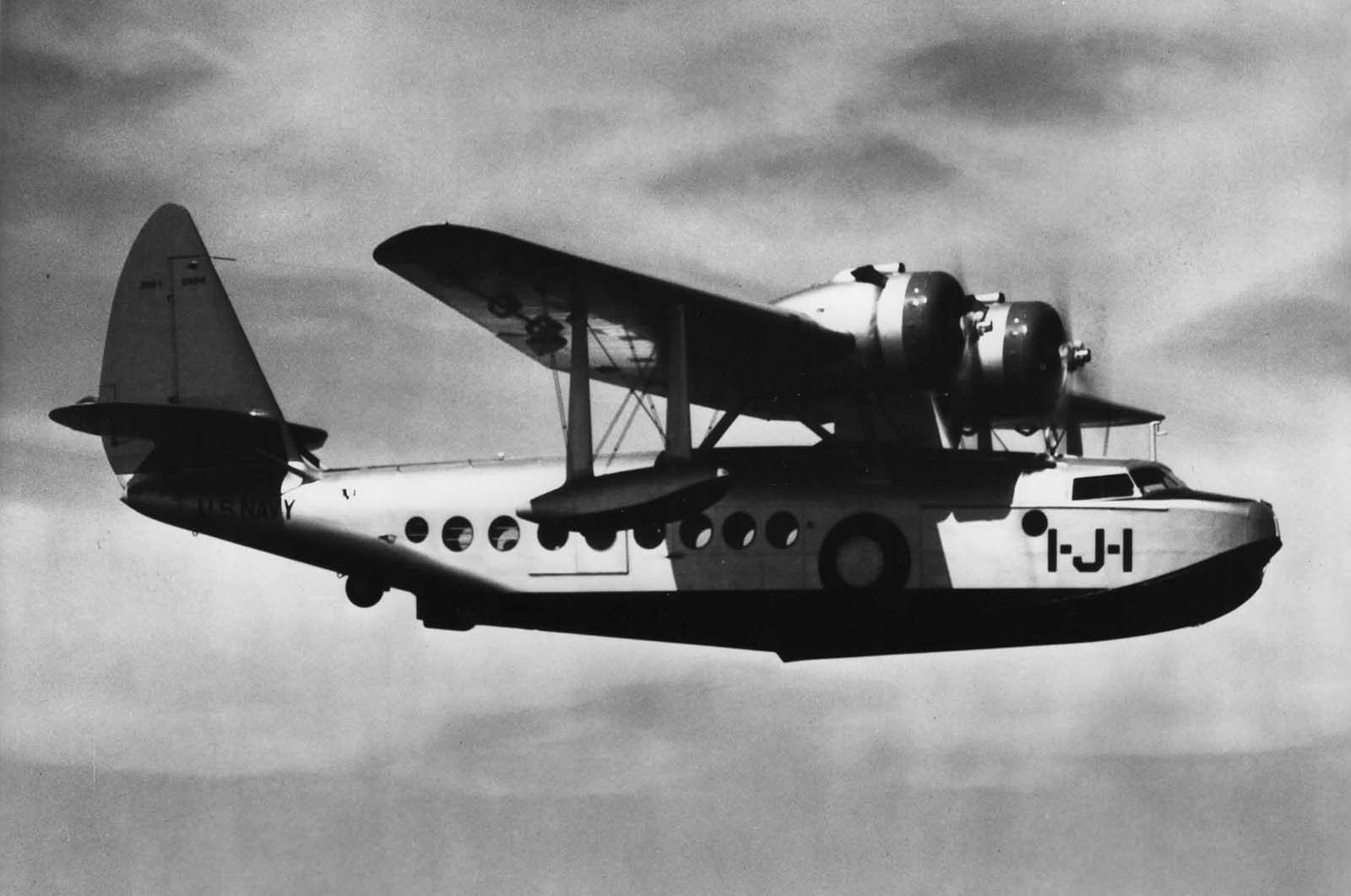
In this atmosphere the gentle, mystical Igor Sikorsky was king. In his office hung an enlargement of the historic snapshot of himself and the late Czar Nicholas, standing in the nose of the world’s first four engine transport plane-his creation. In a corner an icon testified to his devout religious faith. Sikorsky never gave an order to a compatriot. “If you don’t mind,” he would say, or “If this suggestion is not in conflict with your own engineering principles . ..” But so great was his prestige that his proposal became an order. If a man came to him with a suggestion, he would say, “Excellent! Now let’s work it out this way” – and, busily sketching, he would make radical changes. When the part got into production, it was often Sikorsky’s design – but the employee believed it was his.
While trying to weld these charming individualists into an efficient production outfit, we looked over the books and found manufacturing expenses much too high. “There is a limit,” said Fred Rentschler, then president of the company, “to the contribution United Aircraft can make to Russian refugee relief.” So I ordered the manufacturing department to cut expenses 20 percent, which meant paring the payroll. Sikorsky agreed completely. But later I found that engineering salaries had increased by a like amount. And when that budget was pruned, direct labor costs went up. A shop foreman laid off one day, for instance, bobbed up the next at a drafting board, and still later as a lathe hand. The engineers and department heads simply could not understand the need for cost cutting.
Sikorsky tried to explain them to me in his quaintly pleasant English, accenting the last syllable of words ending in “ed” – he had practiced his English in school by reciting the Beatitudes. “Having lost every possession and repeatedly faced death,” he said, “they may not be expected to show concern over financial losses by an impersonal parent corporation, however benevolent.”
The quiet force of Sikorsky’s personality, plus his truly intuitive engineering genius, weighed heavily on the plus side of the dubious ledger. You had to believe in the man. So we whipped things into line after a fashion and planned a new plane.
Sikorsky seemed to carry beneath his distinctive black fedora all there was to know about aircraft engineering, and from under that hat came the famous Flying Clippers (amphibians), which in the ’30’s pioneered the way toward today’s world-wide network of airlines. But the trouble was that, when he proved that his flying boats could cross the oceans safely in one jump, he paved the way for their replacement by land planes. By 1938 we had a factory full of wonderful people, but no orders. There was no help for it; the ax had to fall.
When it was decided to close down Sikorsky production, I thought of the words of a colleague: “There’s a pearl in that Russian caviar somewhere. If you can find it, save it.” As I looked at the waiting Sikorsky, I remembered that.
“I regret to have to advise you,” I said, “that we have decided to discontinue production at the Stratford plant. However, we will be glad to consider any individual research program you have in mind that is within our means.”
“With your kind permission,” Sikorsky said, “I would like to make a few observations of a purely personal nature. I am deeply honoured by your expression of confidence in myself, a feeling which is reciprocated. However, whatever contribution Sikorsky may have made to aviation is the product of several diverse personalities. You will therefore appreciate why I cannot accept responsibility for new research without being assured my little creative group shall remain with me.”
Leaning forward earnestly, he continued, “I would most seriously recommend as the subject of our research the return to my first love, the helicopter.”
At that time no practical helicopter had been produced. At the age of 20 Sikorsky had put together an ungainly craft that wouldn’t rise from the ground, but he said that it “tried to.” Now, 30 years later, he longed to revive this dream of his youth, which experts condemned as folly. I had no confidence in the idea, but as I heard this consecrated man’s impassioned plea – which I soon realized had been carefully prepared – I forgot the skeptics and saw only Sikorsky’s vision.
He dramatically summarized the entire history of aviation as a record of the repeated accomplishment of the “impossible.” This led him to the helicopter. “This project will demand our most serious efforts,” he said, “but we must not look for the answer in ‘reason’ alone. It will demand ‘intuitive engineering’ – and creative faith. For this there is no column on the balance sheet of a corporation under the heading of, capital assets.’ ” A slight flick of the hand dismissed money.
“So important is this development to the future of society that it becomes our responsibility to undertake it,” he continued. “While admittedly radical, and possibly ‘impossible,’ the helicopter is wholly rational. Like no other vehicle, it will operate without regard to prepared landing surfaces. Thus it will free us of the serious handicap to progress imposed by fixed-wing aircraft airport limitations. It is not competitive with the airplane, but complementary to it. If Sikorsky does not create this craft of the future, another will. By training and experience, we are best equip-ped to do it. And finally” – he paused for his clinching stroke – “unlike the airplane, the helicopter will be used not to destroy but to save lives!”
He got the money which he estimated the flight model would cost.
As he left, with dignified thanks, to round up the four engineers he had saved from the collapse, I had a strictly intuitive feeling that I had “saved the pearl.”
Sikorsky began at once working round the clock on his “possibly impossible” vertical-flight machine. In a few months his first report came to my office – probably the most dramatic report ever made by an engineer. It was a reel of color film. When I ran it off, I saw being wheeled out from the hangar what looked like an oversized Meccano toy – a creation of bare metal tubes housing an engine-and the engine run-in test proceeded. More film reports followed, and then came the period of “tethered flight.” Balanced precariously in the nose of the protean “whirlybird,” Sikorsky fought the controls for stability, and finally lifted the machine off the ground. But, in compliance with our instructions, a ball and chain attached to the undercarriage limited its altitude so that he might crash in relative safety.
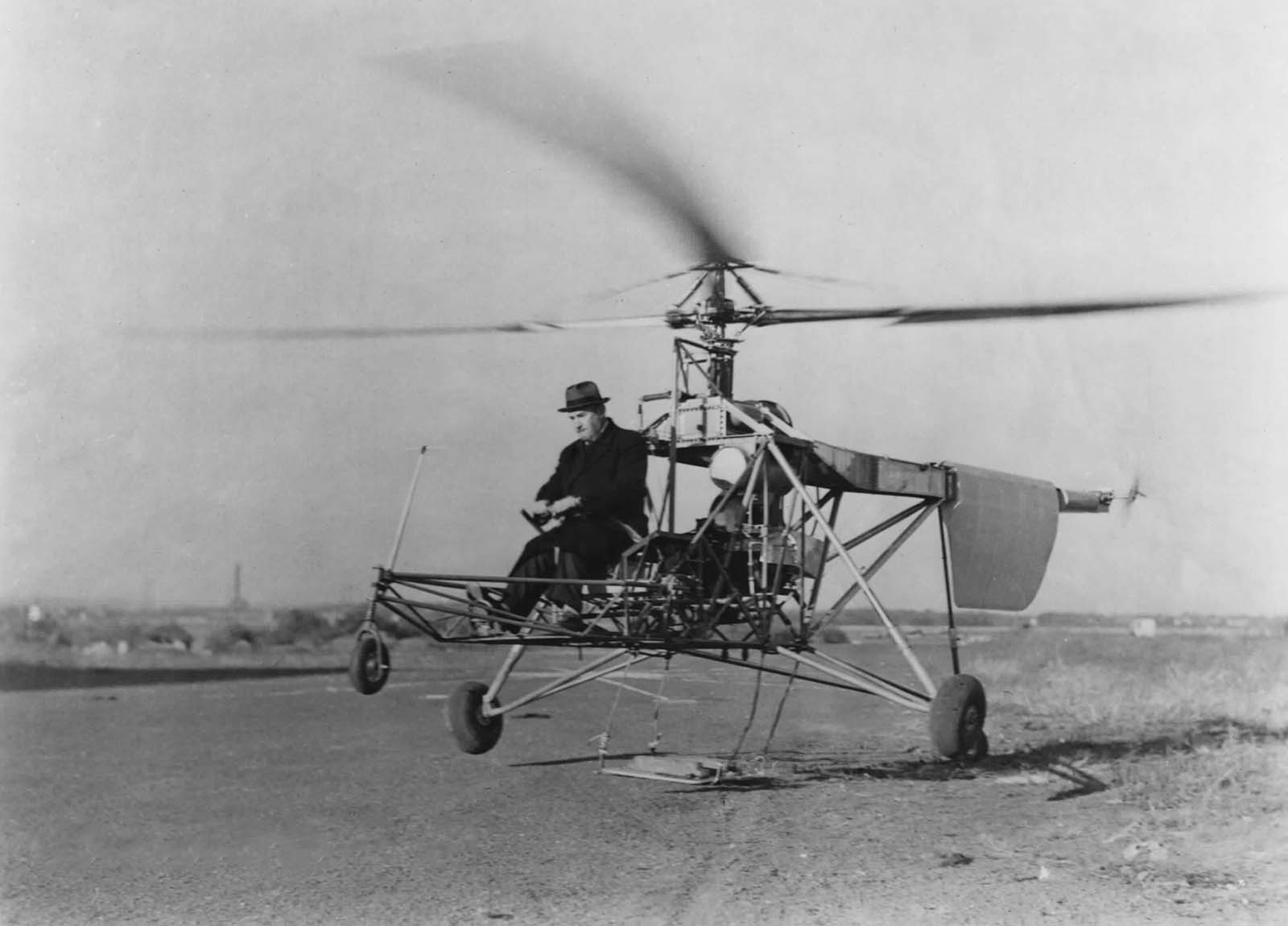
The tether annoyed Sikorsky. One day the machine yanked ball and chain from the concrete, and he phoned me. “We have progressed to the point of being permitted to cast off our shackles,” he announced firmly. “As a pilot you will appreciate the fact that danger lies not in flying through the air but in striking the ground. I therefore respectfully request to be permitted to seek safety in free flight.”
The filmed reports which followed showed me the memorable spectacle of the world’s first helicopter pilot teaching himself to fly the world’s first practical helicopter. Helicopter controls are much more complicated than those of a plane. Horizontal motion is obtained by tilting the overhead rotor a little, so that it pulls the craft in the direction you wish to go. But to keep this rotor from turning the ship around, there is a small vertical tail rotor which counteracts the torque effect and also aids in steering. Sikorsky had to coordinate these moving parts to get smooth control. Riding this pioneer helicopter was like taming a bucking bronco. As he sat there in his business suit and prim fedora on the “front porch” of the craft, he looked like a baffled professor trying to remember his notes, and I marveled that he ever learned to fly the thing.
Watching him ascend and descend, dart right and left and flutter backward, I didn’t notice for a time that he never flew forward. Finally I phoned him about it. “That is a problem we have not solved yet,” he replied blandly. That problem was solved too. It was a matter of handling the controls so as to give the exact amount of power necessary for a forward surge; too much power shot the plane upward.
After many more tests and changes, “Igor’s nightmare” became a practical flying machine. Its rescue career began. Once a conference at the Sikorsky plant was dramatically interrupted by the news that a barge, broken adrift from its tug in a gale on Long Island Sound, was stranded near the shore. A helicopter took off. The pilot, Jimmy Viner, hovering like a hummingbird over the castaways huddled on the barge, lowered the hoist and lifted them to safety. The “angel of mercy,” as it was later called, had put on a demonstration in its own front yard.
Since the first model – the VS300 – more than 1800 Sikorsky helicopters have beaten the air with their lazy wings, and on battlefields, seas and mountains have rescued more than 15,000 people. Inspired by his example, other inventors have produced excellent helicopters of many types. Sikorsky sticks to his single lifting rotor. “Two rotors,” he says, “are like two women in the kitchen. You might think they would do twice as much work, but the efficiency of each is lowered by 35 percent.”
The event I like best to remember came when the historic VS-300 went to its final resting place – the Henry Ford Museum at Dearborn, Mich. There was a large crowd. Sikorsky climbed into the machine, flew toward the stands, stopped before Henry Ford and made the craft curtsy like a circus elephant. With most men this would have been a stunt for the cameras; Sikorsky’s gesture was what he meant it – a salute to a peer.
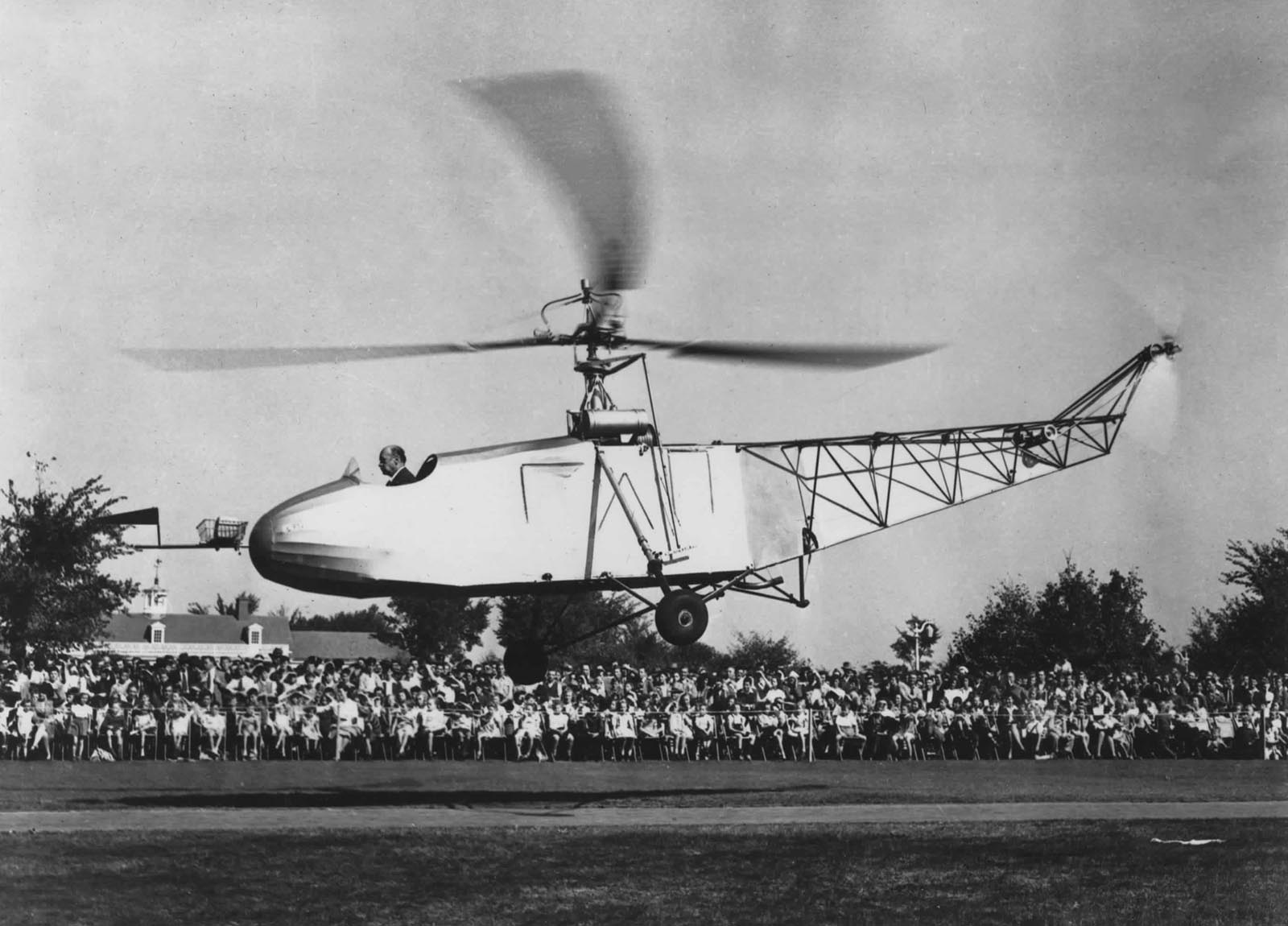
Today, at 67, Igor Sikorsky is still working his engineering intuition at full throttle. He has a big new 18-million-dollar plant at Stratford, in addition to an older one, and 9,000 people find employment in them. He is producing for the armed forces a giant helicopter, powered by two 1,800-horsepower engines, which carries 33 passengers. Sikorsky plans to build this craft, or a larger one, for commercial purposes in 1959. Meanwhile he is experimenting with a gas turbine power plant which may replace the piston engine in his helicopters.
Sikorsky goes to his plant each morning to confer with his staff. But his really important work takes place late at night, when he often sits in the dark and “thinks to music.” An unabashed mystic, he believes that some artists and writers possess the gift of seeing beyond the curtain of time and detecting cloudy visions of things to come. Modestly he suggests that engineers may also share the gift.
Reprinted from the December 1956 Issue of Reader’s Digest
About the Author:
Eugene E. Wilson graduated from the Naval Academy in 1908, and advanced to the rank of commander. He resigned from the Navy in 1930 to become president of Hamilton Standard Propeller Corp., later was president of Sikorsky Aviation and Chance Vought, then became president of United Aircraft, parent corporation of these firms. Now retired, Mr. Wilson is the author of Power for Peace, Slipstream and other books.

